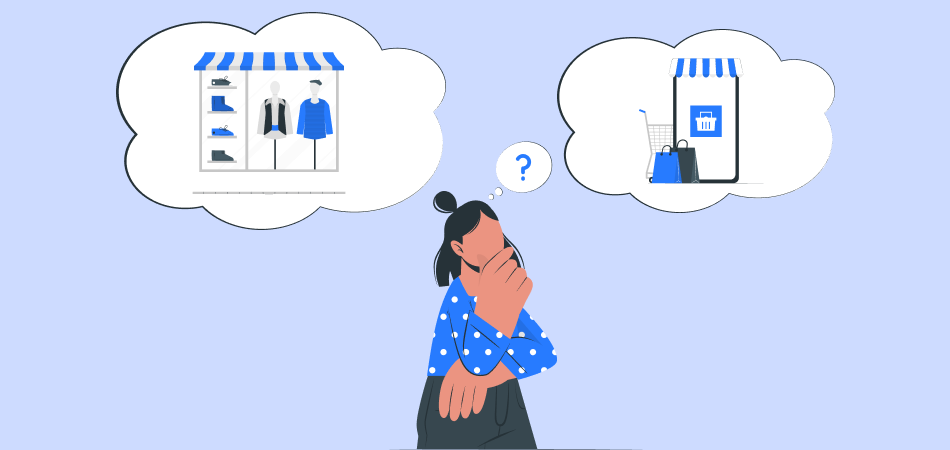How Physical Retail and eCommerce Should Work

In today’s rapidly evolving digital landscape, many would assume that eCommerce is the future of retail, predicting that brick-and-mortar stores will cease to exist in a few years.
The growth of eCommerce is indeed changing the retail industry. However, instead of eliminating physical stores, current trends require brands to combine online and offline services for a more omnichannel experience.
An omnichannel experience is a seamless and cohesive approach where customers can interact with a brand across different channels—online and offline. Through this practice, businesses allow customers to transition from one track to another, providing immense convenience that generates better engagement and conversion.
While there are many steps to creating an omnichannel experience, combining your online and offline services is crucial. Read below to learn more about merging your eCommerce and physical retail processes. Discover the benefits of doing so and the best practices you can try.
Why Combine Physical Stores With eCommerce
Combining your brand’s online and offline experiences is crucial to stand out in today’s highly competitive retail landscape. Here’s how.

Reach a wider range of customers
Focusing on one channel risks alienating a significant portion of your target audience. For instance, while online shopping has become more accessible thanks to smartphones, some consumers still prefer to buy their desired items in-store.
One of the reasons for this is that it allows them to examine a product closely before they finalize their buying decision. Depriving them of the option to buy your products in a physical store will drive these potential customers away.
If you fall behind with the latest eCommerce trends and prioritize your offline experiences, you miss out on reaching and converting potential customers who prefer shopping online. When you give equal attention to your online and offline channels, you widen your brand’s reach and convert people regardless of the outlet they use to access your products.
Build trust by humanizing your brand
Along with the rapid growth of the eCommerce landscape came a surge in online transactions. Digital wallets have revolutionized how online shoppers buy their desired items in the comfort of their homes. Unfortunately, the prominence of these payment gateways has attracted malicious individuals to launch cyberattacks to access a shopper’s account.
Because of that, shoppers are now more vigilant when browsing online stores. Many are reluctant to trust online-only services for fear of falling victim to a scam, so much so that it has become a common habit for shoppers to check public reviews and validate brands before making a purchase.
That’s why businesses strive to boost their human side to establish their credibility in the market. Promoting your offline experiences as much as your eCommerce site is an excellent way to humanize your business. Showcasing your physical store helps gain your potential customers’ trust and encourages them to continue shopping.
Gain more insightful data
Combining physical and online experiences provides brands an excellent opportunity to collect valuable insights or data about their customers. Various tools exist to help them understand through different metrics, including clickthrough rates and cart abandonments. Interacting with customers in person helps elevate the data they gather so they can create better strategies and execute effective decisions.
Integrating data from both physical and online channels helps brands create more concrete customer profiles. Doing so will give them a comprehensive view of their market's preferences, patterns, and lifetime value. This strategy will enable brands to create personalized experiences, recommendations, and promotions across different touchpoints.
Moreover, leveraging data from both channels will help brands manage their resources, particularly their inventory. They can optimize stock levels based on product popularity, allowing them to offer the best ones constantly. It will also help them determine their slow-moving items and make the necessary adjustments so they sell better.
Boost your customer's buying process
The retail industry has a consumer trend called "research online, purchase offline," or ROPO. As the name suggests, shoppers gather all the necessary information online and make a final purchase in-store. This trend is prominent among those shopping for beauty, fashion, and sporting products because they prefer to see and test their desired items in person.

|
Manage Multiple Stores In One Account Multiple Stores Management - Link and manage multiple stores on different platforms in one place |
Improving your online and offline presence is an excellent way to show that you're optimized for ROPO. Providing complete information online and making the same items available in your physical store will help boost a potential customer's decision-making process, urging them to buy more.
Adapt to various market changes
Operating in physical and online spaces helps brands adapt to various market changes or trends in their industry. When online shopping began emerging, people were convinced it would be the future of retail. However, in-person experiences remain critical to a customer's buying journey.
What we can take away from that is consumer behavior can be unpredictable. Some shifts may occur unexpectedly. It could happen online or offline. So, being present on both channels will allow brands to be prepared for any dynamic changes and respond promptly, whether it's adopting new technologies or techniques.
Establish dominance in the market
As discussed above, being present in both physical and online spaces increases a brand's market visibility and reach. That means they can cater to all types of customers, especially those who prefer a certain way to purchase their desired online or offline items.
It's also an excellent way to showcase how successful a business is. While offering online and offline experiences doesn't guarantee putting brands at the top of the mountain, it helps them gain a competitive advantage, allowing them to outperform competitors focused solely on one channel.
Meanwhile, successfully creating a physical and online presence will enable brands to establish market security. That means if one channel falters, they can still cater to their customers on the other. For example, if their online store experiences technical issues, potential customers can still buy products in their physical store, further contributing to a brand's dominance.
Tips for Combining Physical Stores With eCommerce
The following are some of the best practices you can try to offer a cohesive experience between your online and offline channels.

Implement click-and-collect
Click-and-collect is one of the best practices showcasing how brick-and-mortar and e-commerce work cohesively. It's an omnichannel practice where shoppers purchase a product online and collect it at a designated location, whether a physical store or a warehouse locker. Many also refer to this as "curbside pickup" or "buy online, pick up in-store.”
Offering this service is highly convenient for customers. With this option, customers save time from browsing through shelves, filling up carts, and falling in line at the checkout counter. Instead, they skip all that process and acquire the item whenever they want.
The best thing about this service is its high basket value. It will encourage customers to shop more from your store because they save on shipping costs. Plus, it helps cut shipping times, meaning they can collect their items faster than those who choose deliveries at home. Ultimately, with less online and offline waiting time, you significantly boost customer satisfaction and retention through this option.
Showcase your products online
During the pandemic, brands heavily relied on visual content to showcase their products and strengthen their online presence. Among the many content forms that have continued to trend since then is live streaming.
Live streaming has become a go-to for many retailers to promote and demonstrate their products in real time. It's also an excellent avenue for brands to engage with their existing and potential customers.
Aside from featuring a product, you can answer questions, provide usage tips, and offer recommendations. To ensure the best quality, it’s important to optimize your video settings, including the YouTube bitrate, to prevent lag and maintain a smooth viewing experience.
Broadcasting a live stream from your physical store is also an excellent way to give a virtual tour of the establishment and humanize your brand further. It provides an overview of your business's character, reducing online users' doubts and making them feel more secure when purchasing from your brand.
Develop a unified branding
Branding plays a significant factor when creating a cohesive omnichannel experience. Potential customers expect a seamless transition between online and offline shopping, hoping to encounter the same look and feel when jumping from an eCommerce site to your physical store and vice versa.
Consistent branding helps strengthen your market recognition, making you more memorable among your competitors. Combining positive online and offline experiences with unified branding will empower your customers to advocate for your brand better.
Expand your payment options
Digital wallets have become a go-to payment option for many online shoppers. Thanks to popular providers like PayPal, Apple Pay, and Venmo, consumers can handle their finances and make various transactions in a few taps of a button. They’ve become so powerful that they jumped from online purchases to in-store transactions, with many mobile users paying for products and services at checkout counters with their smart devices.
Adapting these payment gateways in all your channels will help make your products more accessible and attainable to potential customers. That way, you prevent abandoned carts from limited transaction types.
The best part is that you can integrate your payment options with your current accounting software. This process allows you to monitor online and offline transactions from such gateways. For instance, you can integrate a PayPal Quickbooks system into your business to track revenue across all channels.
Create a Successful Harmony Between Both Worlds
Combining your online and offline experiences may seem daunting. However, achieving the proper harmony between the two will help make your brand more credible and allow you to provide an excellent omnichannel experience.
The key is to ensure that you provide convenience and accessibility across all channels. That way, you strengthen your brand and reach more people, whether online or offline.












 Company
Company
 Why Choose DSers
Why Choose DSers
 Blog
Blog
 Help Center
Help Center




 Live Chat
Live Chat